Great Zimbabwe
October 18th - October 19th, 1999
This Monday morning we set out for the Zimbabwean border. Kathy has a
friend in Harare, so we decided that we would spend a leisurely four days
working through the 600 kilometers inbetween. Before this, we have to tackle
our very first African border crossing, and it turns out that the Beitbridge
station is one of Africa's worst. The South African side is merely reams
of red tape as this is the point at which we must claim our VAT refund (foreigners
are exempt from sales tax on goods not used or consumed in South Africa,
and most of our camping gear is eligible), but there's a room in hell just
like the Zimbabwean station. Chaos reigns supreme here, all the government
officials truly couldn't care less, and the parking lots and environs are
filled with idle Africans trying to make a buck any way they can from the
foreigners caught in this bureaucratic flypaper. Helpful hint: ignore anyone
trying to flag you down, even those that appear to be in official garb.
They're just hustlers; the officials are safely nestled behind their desks
and barely lift a finger for you, much less stand out in the hot african
sun waiting for you.
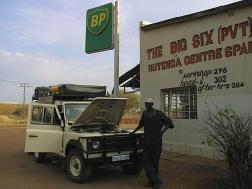 It took nearly three hours, but
we finally make our way through. We make a quick foray into the nearby border
town for petrol and a wallet-choking stack of Zim dollars; at forty Zim
dollars to the US buck and the largest Zim banknote being a hundred, a $100
traveler's check generates a lot of paper. We start bombing our way north
to Masvingo but after an hour or so it becomes apparent that something is
terribly wrong with our Land Rover Spot. Our gas gauge begins to drop at
a very alarming rate: we went through a quarter of a tank in fifty kilometers!
We stop at what might be the only gas station between Beitbridge and Masvingo
and discover that Jim's patch to the carburetor float has given way. The
float is now stuck permanently open, and that petrol is being pumped right
out the back.
It took nearly three hours, but
we finally make our way through. We make a quick foray into the nearby border
town for petrol and a wallet-choking stack of Zim dollars; at forty Zim
dollars to the US buck and the largest Zim banknote being a hundred, a $100
traveler's check generates a lot of paper. We start bombing our way north
to Masvingo but after an hour or so it becomes apparent that something is
terribly wrong with our Land Rover Spot. Our gas gauge begins to drop at
a very alarming rate: we went through a quarter of a tank in fifty kilometers!
We stop at what might be the only gas station between Beitbridge and Masvingo
and discover that Jim's patch to the carburetor float has given way. The
float is now stuck permanently open, and that petrol is being pumped right
out the back.
With the aid of Isaac the mechanic (pictured at left), we isolate the
failed carburetor and run Spot on the remaining good carb. While Spot does
run, our engine power is now less than half of what it once was. So now
instead of barreling down the road at 120kph, the very best we can manage
on level ground is 100kph, and even a slight hill slows us down to 50kph!
We've now joined the throng of slow moving African traffic.
Perhaps the most surprising aspect of our drive to Masvingo is that we
aren't the slowest vehicle on the road. There's more than a few tattered
African trucks struggling along with even more difficulty than we are. We
had hoped to reach Masvingo by mid-afternoon, but it's well after dusk when
we crawl into town. Much of the town is closed, but we do manage to find
the town's caravan park and then limp Spot over to the sole remaining open
restaurant in town, giving us time to contemplate how we're going to tackle
a new country with our wings clipped.
Great Zimbabwe
The morning brings with it a new day and a few new travel rules. We've
decided that unpaved roads are now out of the question given Spot's condition.
Also, after checking a few parts (they call 'em "spares" here)
shops in Masvingo, we quickly find that something is up with Land Rover
spares distribution in Zimbabwe and that no one here can help us. The whole
country is now serviced by a single distributor/dealer in Harare, a good
300 kilometers to the north. We decide that it simply makes the most sense
to head up to Harare ahead of schedule, skipping most of the tourist sights
we had hoped to see along the way. Only one point of interest, the Great
Zimbabwe, is on a paved road, and we decide to make a day of it and camp
at the national park campgrounds there.
First built in the 13th century, the Great Zimbabwe was once the capitol
of a large inland African empire that stretched from eastern Zimbabwe and
Mozambique to as far west as Botswana and as far south as parts of South
Africa. The largest ancient structure in Africa south of the pyramids, the
structures of Great Zimbabwe formed the hub of a city of somewhere between
10,000 and 20,000 people and was supported by commerce in gold and ivory.
Relics from both China and India have been found here, showing that ancient
trade routes knew of this civilization. Abandoned in the 15th century due
to the surrounding land's inability to support that large of a population
without a modern infrastructure, very little is known of the people who
lived here. Pre-colonial Africa had an oral tradition; writing was unknown
and by the time the Portuguese reached here Great Zimbabwe had long since
been empty.
Two major structures make up the bulk of the ruins of Great Zimbabwe:
the Enclosure and the Hill Complex. The Enclosure (pictured below) was home
to the royal family, and actually consists of two concentric walls. Only
the royal family was allowed in the inner enclosure, while priests and servants
could enter the outer. Construction is organic in appearance, with no right
angles or straight lines.
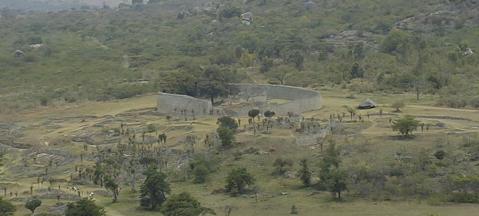
Found right next to the exterior of the inner enclosure lies a striking
stone phallus (below left). The purpose of this structure is of great controversy,
with the best guesses being that it is an altar of some kind. It is known
that it does not contain any treasure or relics, as it was thoroughly picked
through before being restored. Access to this altar for religious officials
was provided by a narrow alley between the walls of the inner and outer
enclosures (below right), an eerie space cold and devoid of light on even
the hottest and brightest of days.
Surrounding the Enclosure are numerous minor buildings and altars; threading
its way through them is a mysterious depressed pathway that is sometimes
no wider than 20cm (that's about 8 inches). No one understands why it was
constructed in such a different fashion from the other approaches to the
Enclosure, and no analogue in other African cultures is known.

The Hill Complex
Overlooking the landscape and predating the Enclosure is the Hill Complex.
Built upon a massive granite mound, the structures of the Hill Complex integrate
themselves within the living rock, seemingly becoming one with it. While
the defensive purposes of the Hill Complex appear obvious, it is believed
that the religious elite lived and worked from here.

The main approach path to the Hill Complex winds its way through the
existing granite rock face and boulders, sometimes squeezing you and the
path through tight crevices. From the top you get a commanding view of the
surrounding hills.
 In this picture to the left you can see how the Enclosure
appears from the Hill Complex; the surrounding city likely filled in the
space around and inbetween them.
In this picture to the left you can see how the Enclosure
appears from the Hill Complex; the surrounding city likely filled in the
space around and inbetween them.
Modern day Zimbabwe makes much of the ancient Great Zimbabwean culture
and derives many of its modern icons from statues found in the ruins, even
though their meaning and purpose is a complete mystery today. The icon of
Zimbabwe is a curious seated bird with mammalian legs, of which half a dozen
or so statues were found here. While the curious bird may be a symbol of
ancient royalty, the moderns are running the risk that the bird's purpose
may be a bit more pedestrian. It's a question that may never be answered,
as the only written record of this culture is a few cryptic mentions in
ancient Chinese diaries and navigation maps.
We spent the evening at the monument's caravan park and found it to be
a pleasant enough stay despite the aging bathrooms and numerous locals walking
through. When the park closes at 6PM, all officials leave and the campers
have the ancient city all to themselves. Kathy and Jim shared a memorable
bottle of wine while watching the sunset from the Hill Complex, and if we
had so desired could have wandered through the ruins all evening.
Thirsty Lizards
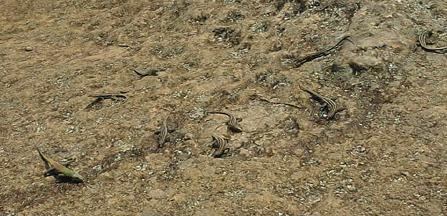
While we were admiring the gestalt of the Great Zimbabwe hill complex,
Kathy brought out one of the bottles of water we carry with us and took
a sip, spilling a small amount in the process. To her surprise, a lizard
ran out from a crevice and started lapping away at the moistened rock, even
though it was only two inches away from Kathy's knee. Amazed, we tried an
experiment: we poured some water in the middle of the large boulder we were
sitting on. The photo above shows the lizard party that ensued. The poor
lizards were obviously dying of thirst, otherwise they never would have
behaved in this fashion. This day was very hot, and it was towards the end
of the dry season so these reptiles hadn't seen rain or even dew in quite
some time.
 It took nearly three hours, but
we finally make our way through. We make a quick foray into the nearby border
town for petrol and a wallet-choking stack of Zim dollars; at forty Zim
dollars to the US buck and the largest Zim banknote being a hundred, a $100
traveler's check generates a lot of paper. We start bombing our way north
to Masvingo but after an hour or so it becomes apparent that something is
terribly wrong with our Land Rover Spot. Our gas gauge begins to drop at
a very alarming rate: we went through a quarter of a tank in fifty kilometers!
We stop at what might be the only gas station between Beitbridge and Masvingo
and discover that Jim's patch to the carburetor float has given way. The
float is now stuck permanently open, and that petrol is being pumped right
out the back.
It took nearly three hours, but
we finally make our way through. We make a quick foray into the nearby border
town for petrol and a wallet-choking stack of Zim dollars; at forty Zim
dollars to the US buck and the largest Zim banknote being a hundred, a $100
traveler's check generates a lot of paper. We start bombing our way north
to Masvingo but after an hour or so it becomes apparent that something is
terribly wrong with our Land Rover Spot. Our gas gauge begins to drop at
a very alarming rate: we went through a quarter of a tank in fifty kilometers!
We stop at what might be the only gas station between Beitbridge and Masvingo
and discover that Jim's patch to the carburetor float has given way. The
float is now stuck permanently open, and that petrol is being pumped right
out the back.

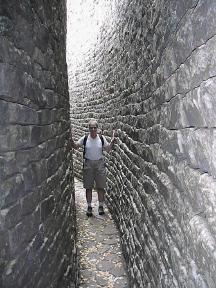


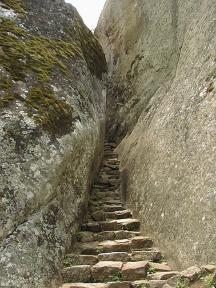
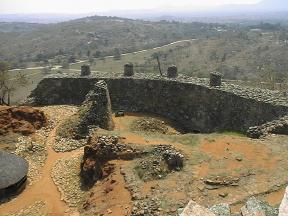
 In this picture to the left you can see how the Enclosure
appears from the Hill Complex; the surrounding city likely filled in the
space around and inbetween them.
In this picture to the left you can see how the Enclosure
appears from the Hill Complex; the surrounding city likely filled in the
space around and inbetween them.